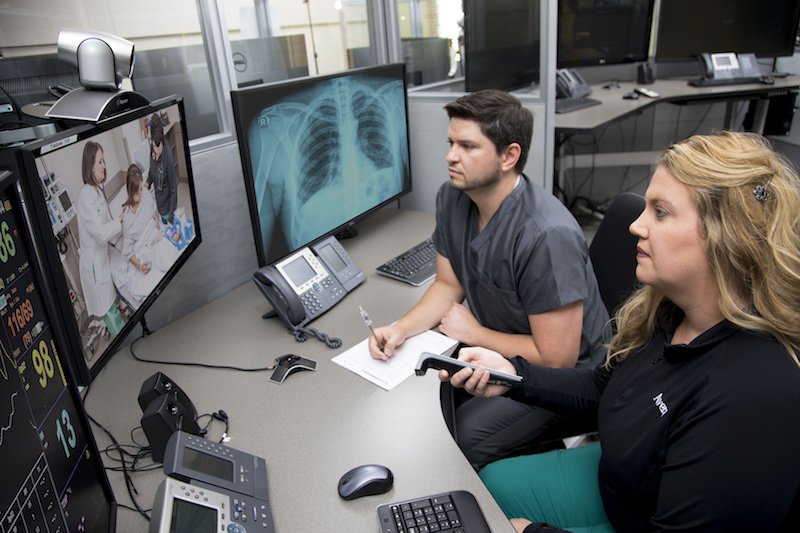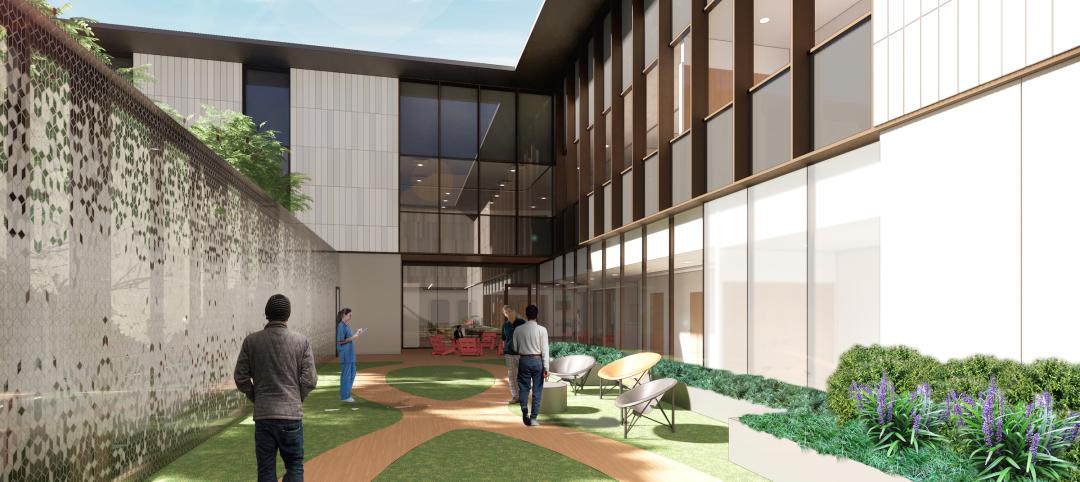Last Spring, construction began on a 16-story, 151-room tower at 139 East 56th Street in New York, which when completed in early 2020 will be Midtown Manhattan’s first purpose-built assisted living and memory care community.
The building—designed by SLCE and Champalimaud, and managed by Sunrise Senior Living—will offer “robust” telehealth services, says Mark Shaver, Senior Vice President-Strategy for Welltower, a leading healthcare REIT that with the real-estate firm Hines is the developer on this project.
“Our communities are proxies to [the patient’s] home, and the 56th Street facility will be the most technologically advanced, with full telemedicine systems so patients can receive care in their rooms,” says Shaver. “This is the future for us.”
Telehealth, which connects clinicians with patients in their homes through mobile devices, and telemedicine, which connects primary care or emergency department clinicians to medical specialists via technology to coordinate patient care, are bringing healthcare closer to where patients live.
At least half of all U.S. hospitals have telehealth or telemedicine programs. Studies have found that a sizable majority of patients doesn’t object to a telehealth option for interacting with caregivers. That’s good news for a medical profession that could face a shortfall of between 42,600 and 121,300 physicians by 2030, according to a recent study prepared for the Association of American Medical Colleges.
While there’s skepticism in some quarters about the extent that the telehealth movement is reducing the need for more medical centers or clinics, there’s evidence that it is helping to lower individuals’ healthcare expenses. For example, last year the University of California at Davis School of Medicine released a study that analyzed data on 19,426 patients over an 18-year period (July 1996 through December 2013). It found that telemedicine visits saved those patients the equivalent of nine years of travel time, five million miles, and $3 million in cost.
Telemedicine “is changing how services are accessed, and is providing access to a larger number of people,” observes James Crispino, Gensler’s Global Practice Leader-Healthcare. “The integration of telemedicine is largely in the development of a technology infrastructure that supports open access by all users, including patients and medical staff. Telemedicine should be seen as a portal to [provider] systems.”
A recent research letter posted by the Journal of American Medical Association (JAMA), based on an analysis of enrollee records from one large national health plan, concluded that while access to physicians via telehealth is still “uncommon” in the United States, consumer demand is increasing. Michael Barnett, M.D., an assistant professor at Harvard’s T.H. Chan School of Public Health and one of the letter’s authors, believes that telemedicine technology will be ubiquitous within the next decade, if current trends continue.
In light of such trends and conclusions, the medical profession and guidelines organizations are taking a closer look at how space for telehealth services should be designed and equipped for the best patient care and operational efficiency.
What can be ‘virtualized’?
This year, Avera Health celebrated the 25th anniversary of its launching of Avera eCARE, a business-to-business telehealth model that connects 400 healthcare sites across 17 states. During a typical month, Avera eCARE serves more than 18,000 patients and saves more than $4.7 million in healthcare costs, according to Deanna Larson, Avera eCARE’s CEO.
“What I always talk about is that when you’re considering a bricks and mortar facility, ask yourself what can be done virtually or with eCARE?” Larson tells BD+C.
Richard Molseed, Executive Vice President for Avera Health, notes that his system “is learning everyday about the eHealth environment.” Now, when Avera Health sets up clinics and EDs, “the first thing we place are the cameras, controls, and monitors.” Telehealth, he says, “has changed the way we practice.”
Avera eCARE has piloted a program that remotely monitors glucose levels of expectant mothers for gestational diabetes. It has expanded nursing services in schools in North and South Dakota by placing telehealth carts with specialized equipment like otoscopes and stethoscopes. It has also set up telehealth kiosks in Hy-Vee grocery stores, from which remote doctors can write prescriptions, and perform blood tests, and test patients for strep and flu.
In 2016, New York-Presbyterian launched NYP OnDemand, a suite of digital health services for such things as second opinions, consultations, follow-ups and urgent care, all available through an online portal.
“It’s meant to provide real-time video conferencing to reduce the need for ED visits, and to free up EDs for higher-need patients,” explains Shauna Coyne, the hospital’s Director of IT Innovation. There are now more than 50 telehealth programs within NYP OnDemand, and as of October 2018 the hospital had more than 60,000 online encounters between patients and remote physicians and other caregivers.
The hospital’s telehealth services include a telepsych initiative with Columbia University and Weill Cornell Medicine, which provides immediate care and limits a patient’s needing to stay overnight in a hospital. (The JAMA letter mentioned above points out that telemental health grew 56% annually to 57,095 visits in 2017 for the enrollees it tracked.)
New York-Presbyterian has set up telehealth kiosks in eight Walgreens pharmacies in New York City, and is piloting a program that allows professionals to monitor patients with Type 2 diabetes from their homes. The hospital’s mobile stroke units are equipped with CT scanners and video capability to connect with a remote neurologist who can monitor the patient’s symptoms and in-field treatment.
While telehealth isn’t leading to a reduction in ED physical space as yet, Coyne says it is making EDs more efficient by treating low-acuity patients at home through an urgent-care app or a drug-store kiosk. For patients who come to an ED, “we are reducing the time-to-provider and discharge times.”
As for the future of telehealth, Coyne expects more hospitals sending patients home with monitoring devices that allow healthcare professionals to track their recovery or status.

A 16-story tower in Midtown Manhattan for an assisted living and memory care community will include “robust” telehealth services. Image: Courtesy of Welltower.
Setting design guidelines
In October 2015, Mercy Virtual Care Center opened in Chesterfield, Mo. The four-story, 125,000-sf facility, which could draw from Mercy’s network of 43 hospitals in five states, almost immediately became the poster child for where telehealth could be headed in terms of integrating virtual services into a continuum of healthcare, and identifying more accessible and affordable care opportunities.
While Mercy Virtual’s size and magnitude—it includes an education center and think tank—haven’t been duplicated, more telehealth centers have been springing up. Coyne notes that New York-Presbyterian has a clinical care center on 60th Street and York Avenue in New York that’s completely virtual. And Avera eCARE’s 34,000-sf hub in Sioux Falls, S.D., provides nine (soon to be 11) virtual clinical services that include neurology, and planning for treatments such as radiology or oncology, says Larson. Avera eCARE also operates satellite telehealth centers in San Antonio, Michigan, and New Hampshire that, says Larson, are under pressure from increasing demand.
Also emerging is a consensus for what facilities need in order to offer telehealth services. Welltower’s Shaver, for one, says any telehealth center must start with strong and reliable WiFi connectivity.
In a piece she wrote for Medical Design + Construction magazine last February, Tama Duffy Day, FACHE, FASID, FIIDA, LEED BD+C, a Gensler Principal who runs the firm’s Health and Wellness practice in Washington D.C., explained that telemedicine’s game-changing trajectory hinges on how well it enables “genuine human connections” between practitioners and patients. Those interactions depend on such things as visual and aural privacy, workstations with movable screens, cameras that facilitate face-to-face contact, and lighting that minimizes shadows and glare.
Day also pointed out that larger-scale telemedicine buildings require increased electricity loads, redundant backup power, and automatic power transfer switching for continuous operations.
The Facilities Guidelines Institute’s 2018 Guidelines for Design and Construction of telemedicine facilities strikes a balance between the physical and virtual by establishing requirements for the size of telemedicine spaces, as well as for their privacy, acoustics, lighting, interior surfaces, site identification, and equipment storage. “Spaces for telemedicine communications should strive to maintain the level of safety, privacy, quality of care, and patient experience that would be expected for communication when it takes place in person,” wrote Ellen Taylor, AIA, EDAC, the Institute’s Vice President of Research, in an article about the new guidelines for Health Facilities Management magazine.
The Department of Veterans Affairs’ Virtual Integrated Multistate Patient Alliance Care Team (V-PACT) program currently serves 85 VA sites around the country that, for whatever reason, don’t have primary care providers or clinicians available. Matthew Rogers, the Clinical Operations Director of this program, says it will send in a virtual team that includes a physician, a pharmacist, and neurologists who provide care for a year remotely from V-PACT’s 15,000-sf hub in Boise, Idaho.
The VA’s telehealth program is organized in a hub-and-spoke arrangement, with 11 hubs combined with physical locations within VA campuses, and some staff who work at home. The VA’s healthcare system is divided into 18 Veteran Integrated Service Networks (VISNs), 10 of which currently are supported by telehealth hubs. Rogers says the goal is to support all VISNs with hubs.
To that end, the VA is in the process of developing a design guide for its telehealth facilities, starting with the Boise hub, which when completed with have at least 70 people on staff, with plans to double that number eventually.
The one thing that Rogers laments is that adoption of telehealth within the VA’s healthcare system has been slow, and that veterans in many parts of the country must still travel long distances to receive healthcare.
Insurance reimbursement is key to expansion
Telehealth is estimated as a $4.5 billion industry. Its growth is contingent, in part, on the extent that insurance covers care. Nearly all states require insurers to provide telehealth coverage. But Larson of Avera eCARE notes that reimbursement from third-party payers is still subject to negotiation some states, and that Medicare only pays for telehealth in rural geographies.
As consumer demand expands, though, insurers’ resistance is likely to soften, especially in states like Ohio, where in late November the health committee of its House of Representatives approved a bill that prohibits healthcare benefits from treating telemedicine services differently from in-person healthcare. That bill has bipartisan support and was likely to be passed by the full House, according to spokesman for Rep. Thomas Patton, the bill’s sponsor.
“Insurance payors are starting to recognize [telehealth] as a cost effective [way] to have earlier intervention,” says Larson.
Related Stories
Sustainability | Apr 4, 2023
NIBS report: Decarbonizing the U.S. building sector will require massive, coordinated effort
Decarbonizing the building sector will require a massive, strategic, and coordinated effort by the public and private sectors, according to a report by the National Institute of Building Sciences (NIBS).
Healthcare Facilities | Mar 26, 2023
UC Davis Health opens new eye institute building for eye care, research, and training
UC Davis Health recently marked the opening of the new Ernest E. Tschannen Eye Institute Building and the expansion of the Ambulatory Care Center (ACC). Located in Sacramento, Calif., the Eye Center provides eye care, vision research, and training for specialists and investigators. With the new building, the Eye Center’s vision scientists can increase capacity for clinical trials by 50%.
Healthcare Facilities | Mar 25, 2023
California medical center breaks ground on behavioral health facility for both adults and children
In San Jose, Calif., Santa Clara Valley Medical Center (SCVMC) has broken ground on a new behavioral health facility: the Child, Adolescent, and Adult Behavioral Health Services Center. Designed by HGA, the center will bring together under one roof Santa Clara County’s behavioral health offerings, including Emergency Psychiatric Services and Urgent Care.
Healthcare Facilities | Mar 22, 2023
New Jersey’s new surgical tower features state’s first intraoperative MRI system
Hackensack (N.J.) University Medical Center recently opened its 530,000-sf Helena Theurer Pavilion, a nine-story surgical and intensive care tower designed by RSC Architects and Page. The county’s first hospital, Hackensack University Medical Center, a 781-bed nonprofit teaching and research hospital, was founded in 1888.
Project + Process Innovation | Mar 22, 2023
Onsite prefabrication for healthcare construction: It's more than a process, it's a partnership
Prefabrication can help project teams navigate an uncertain market. GBBN's Mickey LeRoy, AIA, ACHA, LEED AP, explains the difference between onsite and offsite prefabrication methods for healthcare construction projects.
Modular Building | Mar 20, 2023
3 ways prefabrication doubles as a sustainability strategy
Corie Baker, AIA, shares three modular Gresham Smith projects that found sustainability benefits from the use of prefabrication.
Building Tech | Mar 14, 2023
Reaping the benefits of offsite construction, with ICC's Ryan Colker
Ryan Colker, VP of Innovation at the International Code Council, discusses how municipal regulations and inspections are keeping up with the expansion of off-site manufacturing for commercial construction. Colker speaks with BD+C's John Caulfield.
Healthcare Facilities | Mar 13, 2023
Next-gen behavioral health facilities use design innovation as part of the treatment
An exponential increase in mental illness incidences triggers new behavioral health facilities whose design is part of the treatment.
Healthcare Facilities | Mar 6, 2023
NBBJ kicks off new design podcast with discussion on behavioral health facilities
During the second week of November, the architecture firm NBBJ launched a podcast series called Uplift, that focuses on the transformative power of design. Its first 30-minute episode homed in on designing for behavioral healthcare facilities, a hot topic given the increasing number of new construction and renovation projects in this subsector.
Sustainability | Mar 2, 2023
The next steps for a sustainable, decarbonized future
For building owners and developers, the push to net zero energy and carbon neutrality is no longer an academic discussion.

















